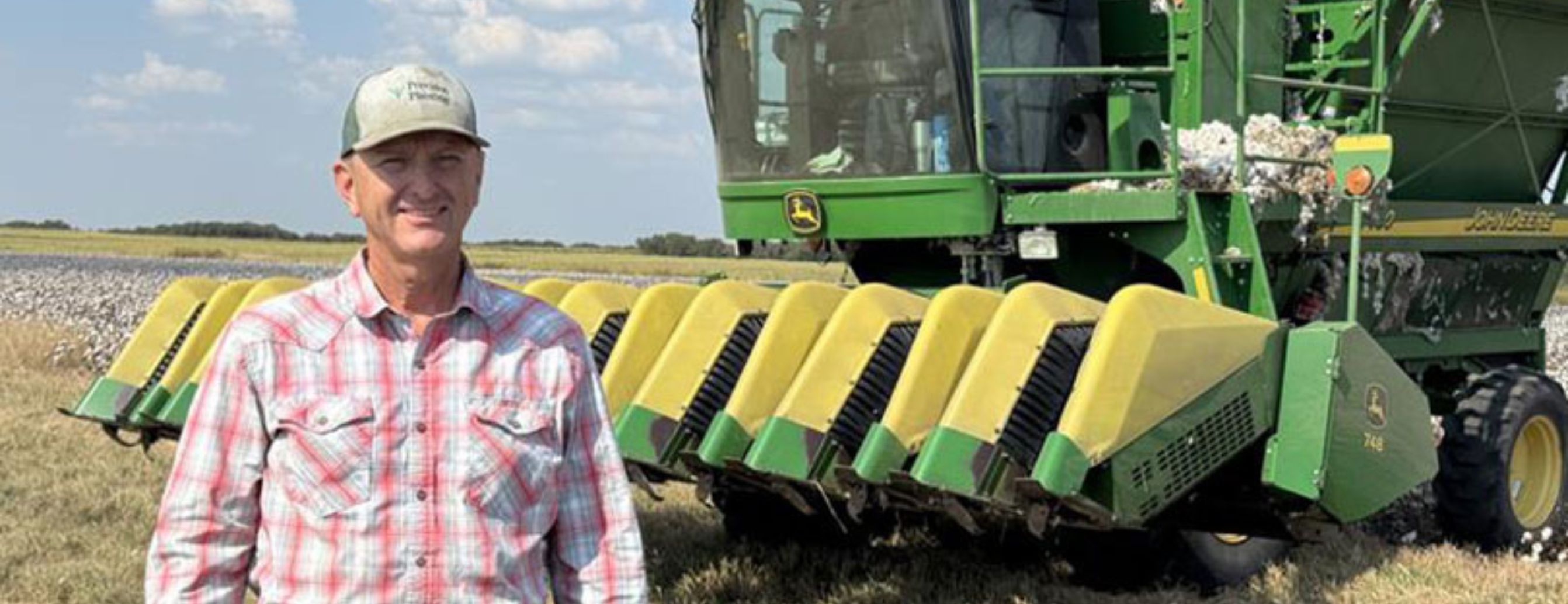
Students Learn About Farm Equipment Through TFB’s Farm From School
Texas students in sixth through twelfth grade recently learned about farm equipment and the technology used to harvest cotton through Texas Farm Bureau’s (TFB) Farm From School program.
The popular program, which expanded this year to include junior high and high school classrooms, connects students across Texas with a farmer or rancher through virtual sessions each semester. These grade levels will “meet” with a farmer online in September and November for 30-minute conversations about agriculture.
In September, Hill County farmer Rodney Schronk took the students along for cotton harvest and taught them about the farm equipment he uses.
“This visit gave students a firsthand look at equipment and machinery that is used during harvest season for cotton farmers,” said Carson Read, TFB education coordinator. “They learned how farm equipment has evolved over time.”
Schronk explained the differences between the machines used to harvest cotton.
“There’s a distinctive difference between a cotton picker and a cotton stripper,” he said. “A lot of cotton is harvested in the United States with a picker, which looks very similar to a cotton stripper. But at the front, instead of having these brushes like you see on a cotton stripper, it has spindles that stick out and turn.”
A cotton picker is suited to pick tall cotton, and Shronk noted cotton strippers work better for the shorter varieties grown across most of Texas.
He showed the students what cotton looks like when it is ready to harvest and discussed the growing process.
As the cotton plant grows, flower buds called squares appear on the cotton plants. In another few weeks, the blossoms open, and their petals change from creamy white to yellow, then pink and finally dark red. After they wither and fall, green pods called cotton bolls are left.
Inside the boll, fibers grow and push out from the newly formed seeds. As the boll ripens, it turns brown. The fibers continue to expand under the sun, and they finally split the boll apart. The cotton bursts from the boll.
“When it is harvested, the burr is left,” Schronk said. “The machine takes the cotton and the burrs, separates them with sharp saws, and then discards the burrs. The cotton is then dumped into a boll buggy.”
The cotton is packed tight in the boll buggy before it’s transferred into a module builder, which compresses the cotton into large modules.
“One module has about 12-and-a-half bales of cotton, which is about 500 pounds of lint,” he told the students.
From there, the modules are covered until they can be transferred to a gin.
Schronk said the cotton gin follows Eli Whitney’s original design, but with modern technological advancements.
“A semi-truck will pick up the modules and haul them to the cotton gin,” he said. “At the gin, they remove any foreign objects that are not wanted, keeping only the lint and seeds.”
The fibers collected from the cotton become thread for clothing, and the seeds are used for many things such as feed for cattle or processed into cooking oil.
Schronk noted that technology has transformed equipment. Today, multiple computers help operate tractors and combines.
“Over the last 20 years, we’ve seen incredible changes in the technology on our tractors,” he said. “At the top of the tractor, there is a global positioning satellite (GPS). It’s what’s in your cell phone, except it’s more advanced.”
He explained that GPS allows for precision mapping and planting, helping farmers to be more efficient.
His tractor has autosteering, controls seed placement and keeps a record of it all, turning it into a digital map.
“Some tractors today are totally autonomous with no driver inside,” he said. “The tractor I am in now drives itself, but it still requires an operator to make sure it’s going in the right direction and that the computer is running correctly.”
He wrapped up the session showing the students how digital applications track crops and equipment use.
“When we put all of this together, we can be more efficient with our fertilizers, insecticides and seed,” Shronk said. “We can be more productive with less.”
The fall 2025 sixth- through twelfth-grade program will virtually meet again in November and focus on dairy.
More information
Farm From School has two separate programs—kindergarten through fifth grade and sixth through twelfth grade.
Click here for more information about the Farm From School program.
Visit texasfarmbureau.org/aitc for more information and the latest announcements on TFB’s Ag in the Classroom activities.






